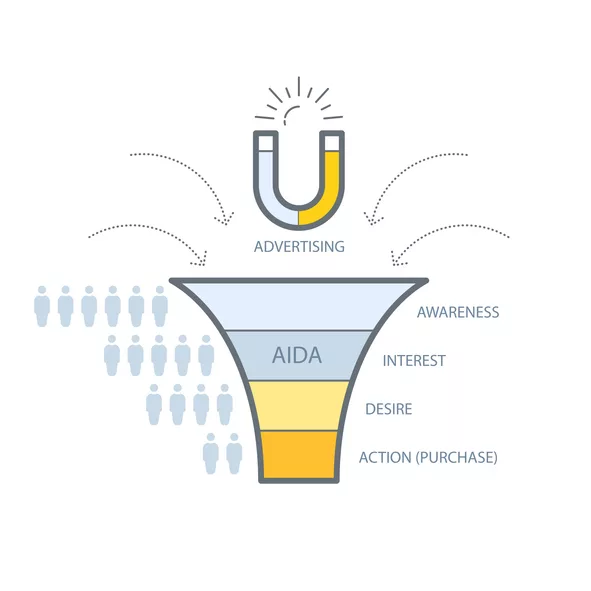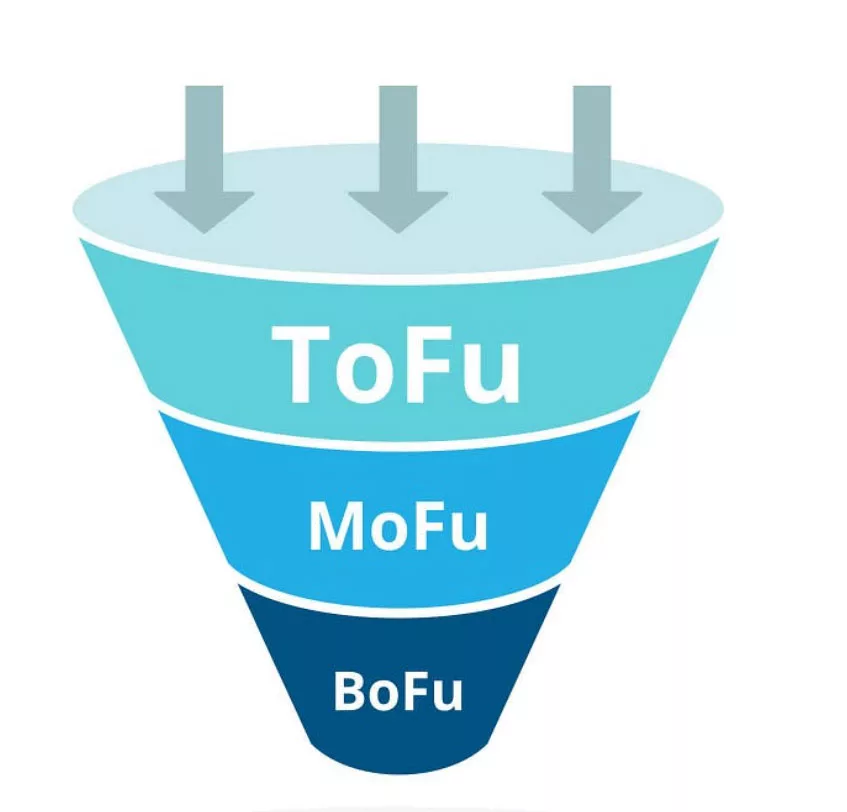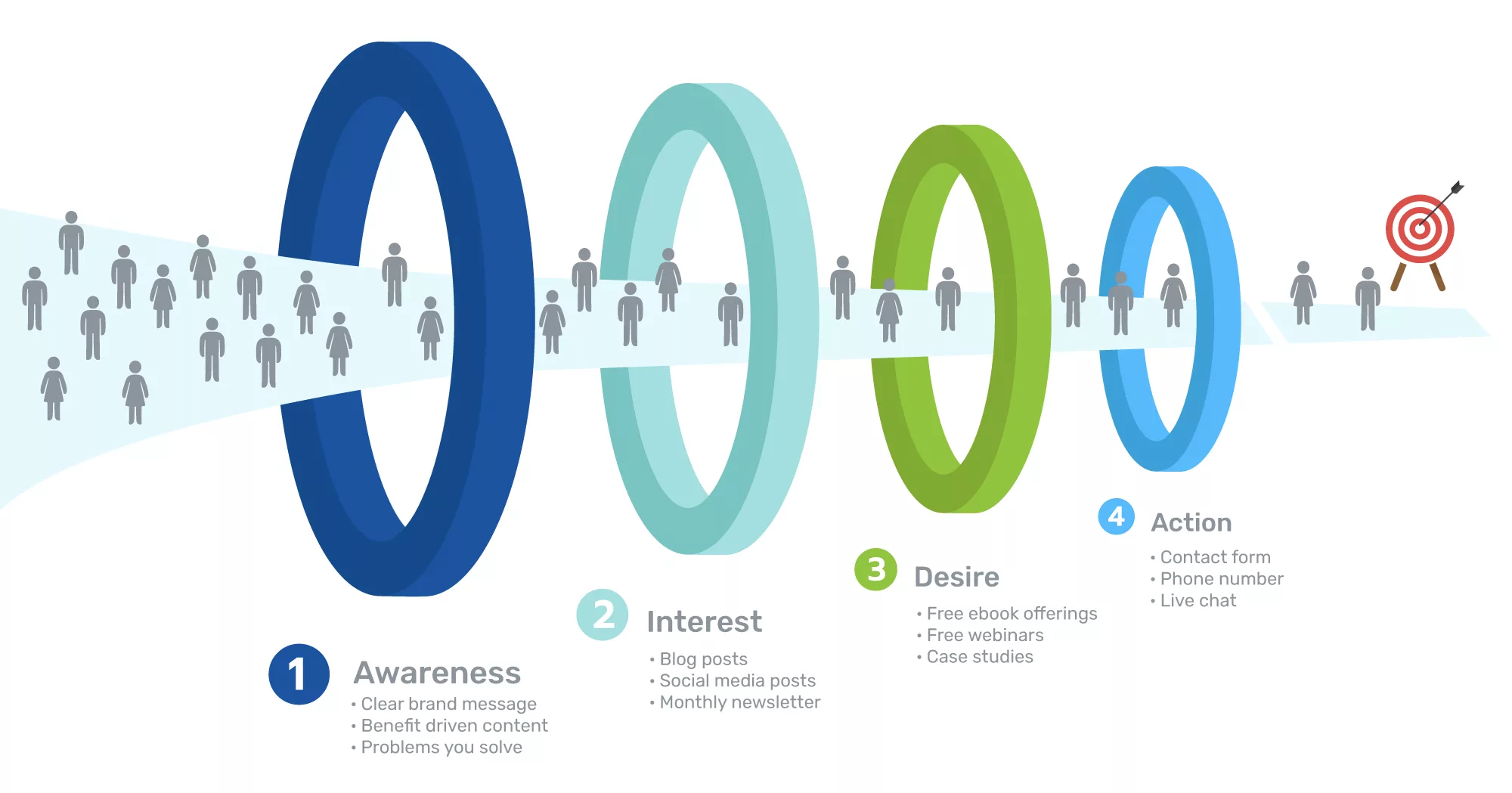Return on investment (ROI) is a key metric in measuring digital marketing success and in many ways the ultimate benchmark to track and measure.
ROI is the fourth step in the Intuitive Websites Four-Step Process, so it’s a topic that comes up early and often with our clients who invest in our digital marketing services and other paid advertising. However, calculating ROI with digital marketing is easier said than done, since not all digital marketing activities and/or leads directly translate into immediate sales.
In this blog post we will share the metrics we monitor when it comes to tracking digital marketing ROI and how ROI relates to movement in the digital marketing funnel. We will explore how different stages of the digital marketing and lead generation funnel contribute to overall business growth.
What is ROI in Digital Marketing?
In simple terms, return on investment (ROI) in digital marketing equates to the profit earned from every dollar you invest in marketing efforts.
When you achieve a positive ROI that means you’re making more than you invested in digital marketing, so the clients or customers you attract offset the cost of acquiring them. On the flip side, a negative ROI means you’re spending more money on marketing than you’re making back.
Some marketing expenses are required and are more difficult to measure direct ROI, like your company website for example. Other digital marketing tactics show a direct correlation between your budget spent and your return.
Importance of ROI in Digital Marketing
Understanding ROI in digital marketing helps determine where your marketing budget is best invested and where to put focus on business growth. Measuring digital marketing ROI shows you what aspects of your marketing plan are working and what needs to be adjusted.
Challenges in Calculating Digital Marketing ROI
While there are plenty of reporting tools such as Google Analytics and HubSpot that track website analytics and customer relationship management, it is often difficult to attribute digital marketing ROI to a single digital marketing activity or campaign.
A potential client may notice a social media post of yours and visit your website where they then sign up for your newsletter. They may open and read your emails and visit your website multiple times, download information, or attend a free event. There are many touch points along the customer buying journey and not every touch point results in a direct lead or sale. It could be months or sometimes even years before a prospect turns into a sale.
What is the Digital Marketing Funnel?
The digital marketing funnel serves as a visual representation of the customer buying journey and research, illustrating how prospective customers move through steps from first exposure to your business online to repeat purchases.
This framework is known as a funnel because it’s set up as an inverted pyramid, or funnel. The top of the funnel is broader and it narrows as prospects express interest and engage with your digital marketing activities. The smallest part of the funnel includes those that take action and turn into a lead for your business.
Your website is a key component in the digital marketing funnel since it is a primary hub for users to take action and reach out to your sales team.
Digital Marketing Funnel Stages
The initial concept of the stages of the consumer journey and marketing funnel was initially introduced by businessman Elias St. Elmo Lewis in 1898 as the AIDA marketing model.
The AIDA acronym stands for the stages a consumer goes through before making a purchasing decision. It stands for:
Awareness > Interest > Desire > Action
In today’s digital world AIDA has evolved to represent the four stages of the digital marketing funnel and helps to determine the way to create and distribute marketing messages to your target audience at each stage of the buying journey.
To note: not every user will follow all of the stages or the same path.

1. Awareness
The digital marketing sales funnel starts when someone first becomes aware of your company, product, or service. This is the widest portion of the funnel.
At this point, the user realizes that they have a problem that needs to be solved and they are learning about possible solutions.
2. Interest
Once a potential customer or client becomes aware of your brand, the next step is to develop their interest and make it easy for them to learn more about your business and what you offer.
Increasing interest starts with users consuming your online content. This is your chance to build authority and credibility. In this stage, prospects could take steps to subscribe to your newsletter or follow you on social media.
3. Desire
The next middle stage in the digital marketing funnel is the desire stage, in which prospective customers are actively seeking solutions that best meet their needs and budget. They could be researching multiple products and/or services.
At this point, it’s important for your business to build trust and rapport with prospects and to stand out with the best answer to their problem and needs.
4. Action
The bottom of the digital sales funnel is where the prospect takes action. They are ready to make a purchase and are looking for the right company to fulfill their needs.
At this point of the digital marketing funnel, your website needs to make it very easy for people to buy from you. Your website should have a clear call-to-action (CTA) that directs people on how to take action and work with you.
How Your Website Can Feed the Digital Marketing Funnel
The chart below shows how your website can contribute to the AIDA stages of the digital marketing funnel.
Lead Generation Sales Funnel Stages in Digital Marketing
It’s natural to want the leads that come in to be customers that are ready to buy from you now. However, it’s important to acknowledge that not every contact or lead will convert into an immediate sale.
Leads progress from information gathering to taking action to contact the sales team. From there it’s up to the sales team to be there to qualify the lead and close the deal.
The lead generation sales funnel helps visualize this process further.

Top of Funnel (ToFu) = Information Qualified Lead (IQL)
Once a prospect hits the “desire” stage of the digital marketing funnel they could subscribe to your newsletter, download an eBook, or attend a free webinar. They provide their email address and enter the top of the funnel (ToFu).
At this point, they become what’s called an Information Qualified Lead (IQL). IQLs are interested in the information that you’re providing and have a desire to learn more, but they are the weakest leads in terms of conversion to an immediate sale.
Middle of Funnel (MoFu) = Marketing Qualified Lead (MQL)
Once a prospect hits the “action” stage of the digital marketing funnel they reach out through a contact form, phone call, or live chat. If they are a legit lead (not spam) then they enter the middle of the funnel (MoFu) and become what’s called a Marketing Qualified Lead (MQL).
MQLs have an expressed interest in what your business has to offer and are more likely to become customers compared to others.
Generally, the marketing team determines whether or not they believe sales would have a good chance at successfully nurturing and converting the MQL into a customer.
HubSpot is a great tool for determining MQLs and tracking movement through the lead conversion funnel.
Bottom of Funnel (BoFu) = Sales Qualified Lead (SQL)
If the sales team agrees that the MQL is a good lead then it turns into a sales-qualified lead (SQL).
An SQL is a lead that the sales team now works to convert into a client or customer.
Are You Prepared to Handle New Sales Leads?
Movement through the lead generation funnel requires sales participation. Once a prospect takes action and reaches out by phone or form, they expect a quick response time.
Make sure you have enough salespeople to handle what could happen when you start digital marketing.
- Do you have someone to answer the phone?
- Are you replying to form completions and email promptly?
- Are you shipping products quickly?
- Are you offering quality customer service?
HubSpot automation makes it easy for a quick response to form completions. Email automation can help fill in the gaps in sales team response times. Quick response times lead to faster close times and increased sales revenues.
Marketing & Sales Alignment
A key part of moving prospects from an MQL to a new customer is to ensure marketing and sales are in alignment. Sales and marketing success comes from alignment on strategy, process, and the people involved.
The team at Intuitive Websites always gleans great marketing insights from talking to our client’s sales team. Sales teams know common objections and questions that prospects ask. Thye know why people buy or are turned away.
Ultimately, sales and marketing should be working together. Your marketing team can learn a lot from the sales team. Make sure they connect.
You can get more tips about this in our CEO, Thomas Young’s book Sales and Marketing Alignment.
Digital Marketing Funnel Metrics to Keep an Eye On
As we’ve now seen, digital marketing plays a role in all phases of the digital marketing funnel from awareness > interest > desire > action.
While sales are the ultimate goal and driver of positive ROI, other data indicators show progress in the right direction.
Here are numbers we keep a pulse on as indicators of progress in each of the digital marketing funnel stages.
Awareness
- Impressions of the website in search (paid / organic)
- Impressions of display ads
- Impressions on social media
Seeing your brand online keeps your business top of mind. It also helps to make your brand sticky, or memorable to your loyal customers. Consider those impressions online. What do people think of when they think of your brand?
Interest
- Number of users who visit the website
- What percentage of users are new vs. returning?
- What are the top pages people are viewing?
- How long are they spending on those pages?
- Where are they clicking on those pages?
- We use Crazy Egg heat maps to measure these
- What channel brought them to the website? (direct, organic, paid, social, email, etc.
- Number of followers on social media
- What are they engaging with on social media (likes, comments, shares)
- Email open rates
Exploring the metrics above gives you an idea of where your website users are coming from and what information they are interested in. Pay attention to the pages people are spending more time on and the information they are reading on your blog, the social posts they react to, and the emails they open. This can give you an idea of the pain points your audience is dealing with.
Desire
- Subscribers to your email newsletter
- Downloads of free offers like eBooks, checklists, etc.
- Number of webinar registrations
- Number of webinar attendees
- Amount of people who have signed up for free samples/demo
- Sign-ups for discount offers on eCommerce
Once the prospect downloads free information in exchange for their email address, the goal is to nurture these leads with more high-value content to help them learn more about your brand and build trust. The goal is to get people to the next action stage.
To note: Automated emails with high-valued content can be done through tools like HubSpot.
Action
- Form completions, calls, emails or interactions with live chat
- Scheduling an appointment with your sales team
How to Measure ROI in Digital Marketing
Now that we’ve explored the digital marketing funnel and lead generation funnel stages, it’s easier to see why it’s complicated to calculate ROI on digital marketing efforts. Not every path has a clear and direct return on investment.
At the end of the day, if you’re going to be able to calculate ROI in digital marketing, you need to keep a pulse on the sales funnel and sales results. There is no way to calculate ROI if you’re not able to pinpoint where leads are coming from and which ones are buying.
When it comes to direct marketing campaigns like Google Ads, it’s easier to measure ROI as each dollar spent with Google is easily tracked alongside how many new leads came in.
Factoring in other digital marketing mediums, however, makes ROI more difficult to measure, since not every marketing activity that takes place now results in an immediate lead or an immediate sale. This is why it’s important to consider direct vs. indirect ROI in digital marketing.
Direct vs. Indirect ROI in Digital Marketing
Direct ROI refers to the immediate return from marketing activities. For example, if a lead directly converts into a sale, the ROI is considered direct. However, it is equally important to recognize the role of indirect ROI.
Indirect ROI encompasses activities that may not have an immediate, measurable impact on sales but contribute to overall business growth. These activities would include brand awareness, brand loyalty, building relationships, or creating memorable experiences.
| Direct ROI | Indirect ROI |
|---|---|
| Sale from the Website (eCommerce) Lead from the Website turns into a Sale Lead from Social or Email turns into a Sale |
Brand Awareness & Stickiness Memorable Brand Experience Word of Mouth, Referrals, Offline Marketing |
Sales Cycles and Long-Term ROI
Sales cycles vary across industries, and it’s important to consider the length of time it takes to convert leads into sales. While immediate results are desirable, some sales may materialize months or even years down the line.
Factors to consider include product complexity, customer behavior, sales strategies, and market conditions. The length of sales cycles can range from weeks to several months or even longer, depending on these factors.
When considering digital marketing ROI keep in mind the length of your average sales cycle and the time gap between when marketing efforts began and when those leads could bear fruit.
Given your industry and the decision-making process that prospects go through before they turn into a customer, positive ROI with digital marketing can take some time.
Understanding your specific sales cycle and factoring it into ROI calculations provides a more accurate assessment of long-term business growth.
Calculate Customer Lifetime Value (CLV)
Customer lifetime value (CLV) measures the average customer revenue generated over their entire relationship with your business.
It is important because it is a key metric in your ROI formula.
Customer Lifetime Value (CLV) = (Customer Value * Average Customer Lifespan)
To figure out customer value you’ll need to calculate the average purchase value and then multiply that by the average number of purchases.
Once you determine the average customer lifespan, multiply that by customer value to determine customer lifetime value.
The longer the lifecycle of a customer, the more value a customer brings in terms of revenue over time. While it may cost more to acquire a new customer, the payoff from retaining that client for future purchases could make for stronger long-term ROI.
Free Website ROI Calculator
To make it easier to track ROI on your digital marketing investment, check out our free website ROI calculator here.
To use it you’ll need to know the following data:
- Website Visitors
- Website Leads
- Visitor to Leads Conversion Rate
- Leads to Sales Conversion Rate
- Avg. Order Amount
- Web Marketing Spend
How to Improve ROI in Digital Marketing
Our Intuitive Websites Four-Step Process ends with ROI, but it starts with strategy. Strategy is a key component that must be in place if you want to improve ROI in digital marketing.
- Having a digital marketing strategy in place ensures that your messaging speaks to the right people, at the right time, in the right places online.
- Once the strategy is set, messaging is on point, and the website design is in order, it’s time to implement digital marketing efforts where your ideal prospects will see it.
- Monitor the digital marketing funnel metrics mentioned before and identify what’s working and where there are areas for improvement.
- Pivot digital marketing efforts as needed, based on data and results.
- Consider creating high-value content and testing different offers. Experiment with new channels and leverage email marketing automation tools.
Nurturing Leads in the Sales Funnel
After taking action to contact you, some prospective clients or customers may not be ready to buy. Continuing to nurture these leads with helpful content via your blog, social media, and email newsletter keeps your business top of mind.
When prospects are ready to take action, your nurturing efforts will help them to remember you. This is where the awareness stage of the digital marketing funnel comes into play again.
HubSpot is a great tool for tracking movement through the lead generation funnel. It gives great insights into the pages prospects are looking at on your website and where they are in the sales funnel process.
We can implement lead scoring in HubSpot that assigns points to actions that visitors take on the website, whether that’s viewing certain pages, completing forms, etc. Once a visitor reaches a certain level of points they could be converted from an IQL into an MQL.
Contact us now for a free HubSpot demo.
Best ROI Digital Marketing
Digital marketing efforts are a key component to feeding your sales funnel via MQLs, but ultimately positive digital marketing ROI is contingent upon your sales team closing the leads.
The best ROI we see with our clients from our digital marketing efforts includes incoming MQLs that go to strong salespeople who can close the deal.
In the end, positive digital marketing ROI is not going to happen if the lead is not qualified and/or a sale is not made.
If you need more assistance with determining ROI on your digital marketing efforts, or if you’re looking to strategically improve ROI on your digital marketing, our team is here to help.
Contact us here today to schedule a free consultation.



